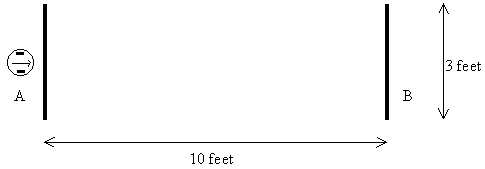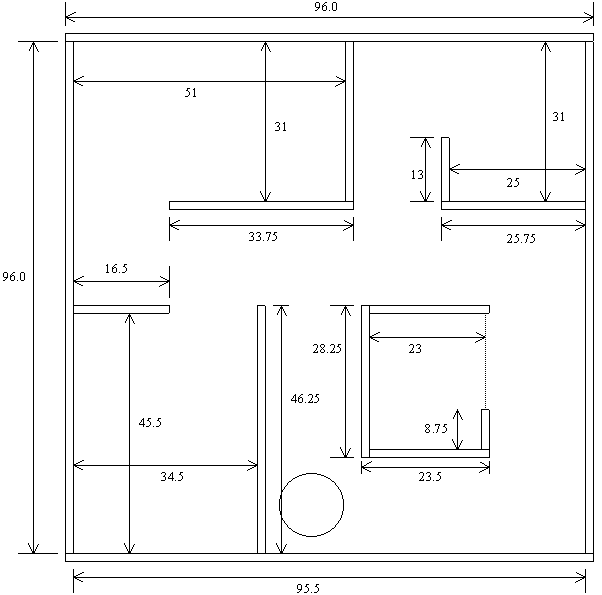
It is interesting to run various tests at various levels of development of your Ebot to determine how well it performs, and perhaps, to evaluate how much of an improvement was made by adding a feature. These tests can also be used as contests if you have anyone to compete against.
The first test is meant to be performed as soon as you have a robot which can go forward and turn. The usual case is that the robot has two hacked servos for drive and a processor to drive them. Hence, you can set the robot up to go forward (or reverse) and to make pivot or radius style turns. So the first test is to evaluate how accurately the robot can do these things.
We used the following test at the RSSC group meetings to compare our results.
Contest 1:
The goal is for the robot to go straight forward for a
distance, pivot 180 degrees to point back, and then return to the starting
point. The contest is run on a hard floor for best performance.
Draw two parallel lines on the floor (tape works well).
The lines should be 3 feet long and 10 feet apart.

First, you place your robot at point A, behind the line, aim it toward the line at B and send it on its way. Scoring is done as follows: you get 20 points if any part of your robot crosses line B and 10 bonus points if all of the robot crosses within the line width. The robot then should turn back toward A. It gets 10 points more if any part of the robot crosses line B on the way back. Plus 30 points if any part of the robot crosses line A on the way back and 20 bonus points if the robot fully crosses line A and then stops.
Sounds easy? Maybe not. To do this test accurately, you will have to get your motors tuned up well (in software) so that they go the desired direction and speed.
This test should be run before encoders are installed to demonstrate how DIFFICULT it is to get accurate performance just by driving the motors. You'll find that your accuracy will vary depending on the floor you run on, the state of charge of you batteries and how warmed up the motors are (not to mention the phase of the moon).
After conquering this test, your next project should be to add wheel encoders to the robot and find how much more accurate your performance can be. Try this test again with encoders, and you'll see that suddenly it is very easy and it's time to move on to more advanced tests.
Contest 2:
To provide more of a challenge for our Ebots, and to make use of available equipment, Contest 2 will require your Ebot to navigate around Don Fear's copy of the Trinity Firefighting robot contest arena (house). The scoring system will attempt to allow Ebots at all levels of capability to compete; but for the most sophisticated robots to get the best scores. The dimensions below are from the Trinity contest description and are very close to Don's arena. The main difference is that Don's arena is constructed of 1/4 inch foam board rather than 3/4 inch particle board for portability.

Proposed rules are:
The Ebot is to start within the circle (a 12 inch circle centered in the hallways) and travel throughout the arena going to as many rooms as possible.
Scoring will give 10 points for each room entered (robot fully past the doorway), 10 points for each room exited (fully outside the doorway) and 20 points for stopping at the circle (any part of the robot over the circle and the robot comes to a stop in that position). Points for stopping in the circle will only apply if the robot has successfully entered at least one room. This will give a maximum score of 100 points.
Approaches to the contest will include basic dead reckoning, with or without encoders; or using some form of sensors to navigate along the walls.
A simple wall following implementation will just follow the wall to the left or right, hence permitting the robot to visit 3 of the rooms, touring their interiors before exiting, but will not succeed in finding the small central room.
To go to all 4 rooms, a more sophisticated navigation strategy will be necessary; either a very accurate dead reckoning scheme or a more sophisticated navigation scheme using wall following sensors as well as some dead reckoning.